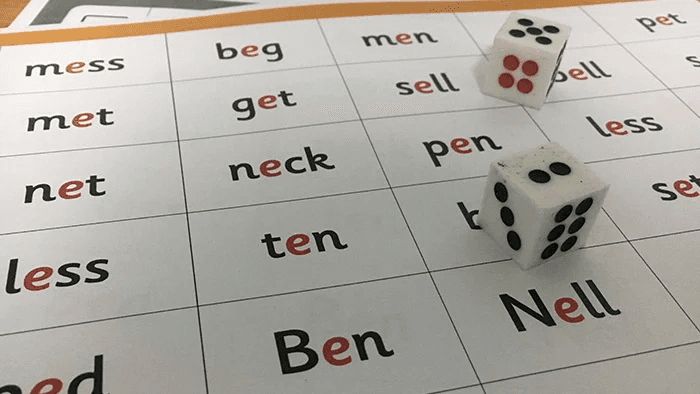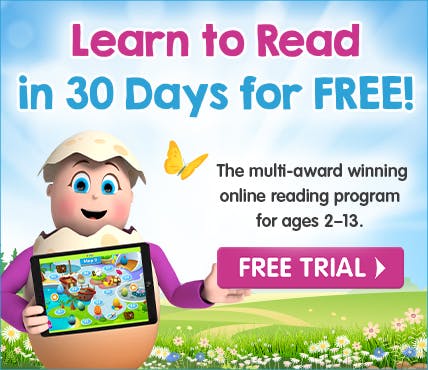


Help kids crack the reading code with phonics

Give your child a head start with phonics in a fun, engaging way with the multi‑award winning Reading Eggs. Your Free Trial also includes Fast Phonics to build even further on phonics!
The importance of phonics for young readers is apparent with many school curriculums around the world adding a greater emphasis on this area to help kids learn to read. Phonics is one of the five key areas in reading instruction, along with phonemic awareness, fluency, vocabulary and text comprehension. The main aim of phonics instruction is to help beginning readers understand that letters are linked to particular sounds. The science of reading, a collective that focuses on researching and developing best practices for teaching foundational literacy skills backs this up. For students to succeed, they need explicit instruction with a systematic way of teaching, focusing on the main components of reading.
How kids learn to read
Children learning to read must acquire a number of complex skills that enable them to make the necessary links between the sound that words make and the way that they appear on the page.
It is particularly important that beginning readers recognise the relationship between written letters and their sounds. This is because English spelling is based on the alphabetic principle, the notion that letters of the alphabet, or letter combinations, represent speech sounds.
In English, there are 26 letters used to represent 44 unique sounds (phonemes). Armed with the knowledge that letters are symbols that represent sounds, beginning readers are able to then recognise letter‑sound correspondences and spelling patterns, and use this knowledge in their reading.
While phonemic awareness allows a child to hear these individual sounds as part of spoken words, phonics instruction enables young readers to recognise that these smaller units of sound correspond to written letters.

It's important for early readers to grasp the connection between the sounds and letters of the alphabet. Reading Eggs offers the perfect activities to help kids with this concept. Free trial
A thorough understanding of phonics and this alphabetic principle is crucial for a child learning to read. Insufficient or inaccurate phonics instruction can detour a young reader from making the necessary links between the written word and the spoken word that it represents. Failure to make these links can result in reading delays.
Analytic VS Synthetic Phonics
Systematic phonics instruction, which offers young readers plenty of opportunities to make the necessary links between letters and sounds, helps young readers along the way to reading success. There are, however, different types of phonics instruction, the main two being synthetic phonics and analytic phonics.
With analytic phonics, children are taught to recognise whole words by sight, and later to break down the word into the smaller units of sound.
In contrast, synthetic phonics is a more accelerated form of phonics. Children are taught letter sounds even before they are introduced to books, before they learn to read and prior to starting school.

Kids learn best when it's fun, so Reading Eggs and Fast Phonics are full of games, activities and videos to teach phonics skills in engaging ways. Free trial
They learn the sounds of the letters in their smaller units, and then learn to put them together, or synthesise them, as it were, hence the name “synthetic” phonics. For example, they first learn the sounds 'c', 'a', and 't' before the letters are put together to form the word 'cat'.
Discover how Reading Eggs can help your child to read
At Reading Eggs our focus is on helping kids learn to read, with scientifically proven methods created by our skilled educators. Our programmes aim to foster a love of reading through phonics instruction, starting with Reading Eggs (ages 3–7) and delving deeper into this area with Fast Phonics (ages 5–10).
With the Reading Eggs programme, children begin by learning the appropriate sound for each letter of the alphabet.
Each letter of the alphabet is featured in its own lesson, and lessons build on one another systematically, so that after just nine lessons, children are able to read their first book.

Teaching individual letters and their sounds is the starting point of phonics. This fun activity in Reading Eggs reinforces this skill until kids get it, before moving on to letter combinations. Get your 30‑day Free Trial today!
In the first 60 lessons of Reading Eggs, all the books are highly decodable, using words that have been introduced and reinforced by the lessons. The programme responds to readers at their level of ability, making it possible for children to consistently read at their level, which is the most beneficial for their learning.
If the lessons are too easy, children lose interest; if they are too hard, children lose motivation. But pitch a lesson right at a child's level, interest and motivation is maintained, and reading comprehension grows along with reading success.
As well as working through the alphabet, and the sounds that each letter (or letter combination) makes, Reading Eggs also includes lessons on phonics skills such as working with beginning and end blends of letters, the variety of sounds that vowels make, digraphs, consonant letter sounds such as soft c, g, and y, silent letters, word families, onset and rime and how to work through words with more than one syllable. The Reading Eggs programme helps young readers develop these phonics skills; lessons build on one another, and reading skills improve upon the completion of every reading activity.
By using the Reading Eggs programme, children enjoy learning to read. All of the lessons, including the lessons on phonics, are embedded in game‑like activities that encourage the children to play as they learn. When children succeed at the activities, they are rewarded with prizes, such as the Golden Eggs they receive at the end of each short activity they complete. With the lessons being so enjoyable, young readers enjoy spending time in the Reading Eggs programmes, and the more time they spend in the programme, the more that they learn!
Why Fast Phonics?

Fast Phonics highly engaging phonics games and motivating rewards help to keep kids on track and eager to improve their skills. It's also helpful for older reluctant readers and kids struggling at school.
Fast Phonics is a standalone phonics programme that builds on the phonemic awareness and phonics skills covered in Reading Eggs. Its systematic, synthetic phonics approach is suitable for emergent and early readers, ESL/ELL learners, and older students with gaps in their core reading knowledge.
Fast Phonics helps accelerate children's skills with sequenced lessons, videos, activities, and decodable books. Eggsplorers will love the 20 vibrant levels in Fast Phonics, which are presented as Mountain Peaks with funny characters.
In each peak, children learn a new set of letters and sounds and complete more than 20 activities where they learn to blend the sounds together to make words and segment words into phonemes for spelling. They will then read fully decodable books to reinforce the new phonics skills they've learned.
The fun, animated videos in Fast Phonics teach systematic, synthetic phonics knowledge and skills. These letter‑sound videos incorporate powerful visual memory aids known as visual mnemonics, that are proven to boost letter-sound recognition.
See, helping kids learn phonics doesn't need to be complicated! Fast Phonics provides a clear roadmap, backed by scientific evidence. By ensuring these lessons are delivered in a fun way that engages children we make sure phonics skills are retained, and kids are set on the best path to becoming proficient readers.
Try Fast Phonics and Reading Eggs for FREE!
Fast Phonics is Reading Eggs' online synthetic phonics programme. Based on solid scientific research, Fast Phonics uses the proven power of systematic phonics instruction to boost kids’ reading skills fast! With 20 fun‑filled levels to give your child an understanding of key phonics skills including letter‑sound recognition, blending and spelling.


